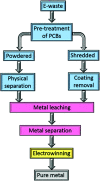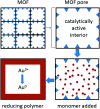Challenges and opportunities in the recovery of gold from electronic waste
- PMID: 35495234
- PMCID: PMC9049023
- DOI: 10.1039/c9ra07607g
Challenges and opportunities in the recovery of gold from electronic waste
Abstract
Rapid global technological development has led to the rising production of electronic waste that presents both challenges and opportunities in its recycling. In this review, we highlight the value of metal resources in the printed circuit boards (PCBs) commonly found in end-of-life electronics, the differences between primary (ore) mining applications and secondary ('urban') mining, and the variety of metallurgical separations, in particular those that have the potential to selectively and sustainably recover gold from waste PCBs.
This journal is © The Royal Society of Chemistry.
Conflict of interest statement
There are no conflicts to declare.
Figures









References
-
- Baldé C. P., Forti V., Gray V., Kuehr V. and Stegmann P., The Global E-waste Monitor 2017, Report 9789280890532, Geneva, Bonn, Vienna, 2017
-
- World Economic Forum: A new circular vision for electronics - time for a global reboot, https://www.weforum.org/reports/a-new-circular-vision-for-electronics-ti..., accessed 13/01/2020
-
- Cucchiella F. D'Adamo I. Lenny Koh S. C. Rosa P. Renew. Sustain. Energy Rev. 2015;51:263–272. doi: 10.1016/j.rser.2015.06.010. - DOI
-
- UNEP, Recycling - From E-waste to resources, July 2009
Publication types
LinkOut - more resources
Full Text Sources
Other Literature Sources

